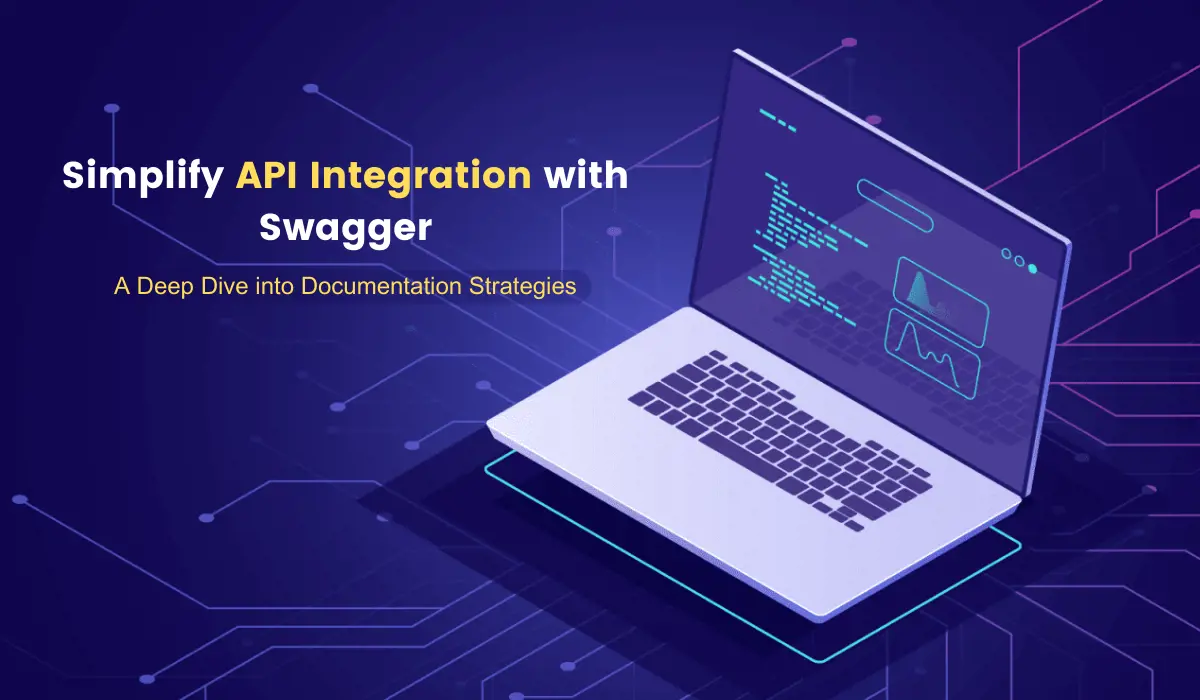Simplify API Integration with Swagger: A Deep Dive into Documentation Strategies

Are you tired of grappling with complex API integrations that leave you tangled in a web of confusion? If so, Swagger API is your secret weapon to break free from the shackles of convoluted API documentation and integration challenges.
In this blog post, we will explore how Swagger, a robust API documentation and integration tool, simplifies the process and offers strategies to elevate your API integration game. Experience the true potential of Swagger API documentation and free yourself from the intricacies of API integrations.
Explaining API Integration
API integration connects different software systems to enable data exchange and interaction. It involves defining how other components of an API work together, specifying the input and output formats, and handling various scenarios such as authentication, errors, and versioning. Successful API integration ensures that applications can seamlessly collaborate and share information, enhancing their overall performance and functionality.
Introducing Swagger for Documentation and Integration
Swagger is an open-source framework that provides tools for designing, building, documenting, and consuming RESTful APIs. It started as a project to simplify API documentation, but it quickly evolved into the OpenAPI Specification (OAS), an industry standard for API description. The OAS allows developers to create machine-readable API documentation, enabling automated code generation, testing, and validation.
As Swagger gained popularity, it evolved into the OpenAPI Specification, solidifying its position as a widely adopted API documentation standard. The OAS provides a clear, human-readable description of an API, covering everything from available endpoints and request/response payloads to authentication methods and error handling.
Key Features and Benefits of Using Swagger
Swagger comes packed with several features that make it a preferred choice for API documentation and integration:
- Consistency and Clarity:
Swagger ensures uniformity and clarity in API documentation, making it easier for developers to understand and interact with APIs.
- Automated Code Generation:
It allows for the automatic generation of client libraries in multiple programming languages, reducing the effort required for API consumption.
- Interactive API Documentation:
It helps in generating interactive and user-friendly API documentation that allow developers to explore endpoints and test API calls directly from the documentation.
- Collaborative Development and Testing:
Swagger fosters collaboration among development teams, testers, and stakeholders, streamlining the development and testing process.
Why is Swagger a Popular Choice for API Documentation?
Swagger has garnered immense popularity due to various reasons:
- User-Friendly Interface:
Swagger's intuitive design and user-friendly interface make it accessible to experienced and novice developers.
- Industry Recognition:
As the OpenAPI Specification, Swagger is widely recognized, making it easier for developers to adapt to different projects and teams.
- Extensive Tooling Support:
Swagger offers a vast ecosystem of tools, plugins, and integrations, further enhancing its capabilities.
- Community Support:
The Swagger community is vibrant and supportive, providing valuable resources, best practices, and assistance for API documentation.
Swagger Documentation Strategies
Swagger serves as a comprehensive documentation solution, addressing every aspect of API documentation. With Swagger, developers can clearly define endpoints, request and response payloads, query parameters, headers, and authentication methods in an organized manner. The platform centralizes API specifications, promoting consistency and clarity in the documentation. As a result, developers find it easier to understand and interact with the API.
Advantages of Using Swagger for API Documentation
Swagger brings many advantages regarding API documentation, making it a go-to choice for developers worldwide. Let's explore these key benefits that elevate the API development process:
- API Design-First Approach:
Swagger promotes a design-first approach to API development, wherein developers define the API contract before diving into writing the actual code. This methodology fosters a clear and unified understanding of the API's purpose and functionality across the entire development team. A well-defined contract in place enables a more streamlined and efficient development process.
- Interactive API Documentation:
One of the standout features of Swagger is its interactive API documentation capability. Developers can explore and interact with the API directly from the documentation itself. This real-time interaction saves valuable time, reduces ambiguities, and facilitates a smoother API integration experience. With interactive documentation, developers can quickly grasp how the API functions and experiment with its various endpoints, improving overall efficiency and fostering a deeper understanding of the API's behavior.
- Code Generation Capabilities:
Swagger offers the powerful feature of automatically generating client libraries in multiple programming languages. This capability dramatically simplifies the process of consuming APIs, as developers can easily access pre-generated code snippets tailored to their preferred language. By reducing the manual effort involved in writing API client code, this feature minimizes the chances of errors and inconsistencies, ensuring a more reliable integration process.
- Collaborative Development and Testing:
Swagger is a centralized platform facilitating collaboration among developers, testers, and stakeholders during the API specification phase. This collaborative environment encourages effective communication and a shared understanding of requirements, creating stronger APIs. When all relevant parties are involved in the API design process, potential problems can be detected and addressed early, resulting in a higher-quality final API product.
Working with Swagger: Step-by-Step Guide
Swagger has revolutionized API documentation, streamlining the process and making it more accessible. This step-by-step guide will walk you through working with Swagger, from installation to deploying and hosting your documentation.
- Installing and Setting up Swagger:
Install Swagger in your development environment to get started. Depending on your programming language and framework, you can choose from various Swagger integrations, such as Swagger UI for JavaScript-based applications or Swashbuckle for .NET projects. Once installed, configure Swagger to work with your API.
- Creating an OpenAPI Specification Document:
The core of Swagger is the OpenAPI Specification (OAS) document. It is the foundation of your API documentation and outlines essential details, including endpoints, request/response models, and security requirements. You can create the OAS document manually or use tools like Swagger Editor to design and validate your API specifications visually.
- Documenting APIs using Swagger Annotations or a Code-First Approach:
Swagger provides two primary approaches to document your APIs. First, you can annotate your code with Swagger-specific annotations or decorators. These annotations serve as metadata and generate the API documentation automatically. Alternatively, you can adopt a code-first approach, creating your API endpoints and models in code, and Swagger will generate the OAS document based on your code.
- Generating Interactive API Documentation with Swagger UI:
Once your APIs are documented, Swagger UI comes into play. It is a powerful tool that renders your OAS document into an interactive and user-friendly documentation page. Developers can explore endpoints, execute test calls, and view response examples directly from the Swagger UI, making it easier to understand and consume your API.
- Integrating Swagger with API Testing Tools:
To ensure the reliability of your API, integrate Swagger with API testing tools like Karate Labs or Postman. By leveraging your OAS document, these tools can generate test cases automatically, enabling you to perform thorough testing and validate your API's functionality.
- Deploying and Hosting Swagger Documentation:
With your Swagger documentation ready, deploy it to your preferred server or hosting platform. You can host it on your website or use dedicated hosting services like GitHub Pages or Amazon S3. Ensure that the Swagger documentation remains accessible to your team and API consumers.
Improving API Integration with Swagger
Improving API integration is crucial to modern software development, as seamless communication between applications is essential for delivering efficient and robust solutions. However, API integration can be complex and error-prone, often requiring extensive documentation and rigorous testing. Here's how Swagger enhances the API integration process.
- Validation and Error Handling using Swagger
Ensuring data integrity and accuracy is vital for API integration. Swagger's validation capabilities allow developers to define data models and validation rules, ensuring incoming data adhere to the specified format and requirements. Swagger's comprehensive error-handling documentation also guides developers and consumers on handling exceptions gracefully, leading to a more user-friendly experience.
- Versioning and Backward Compatibility Considerations
APIs evolve, introducing changes that must be managed carefully to maintain backward compatibility. Swagger enables versioning by allowing developers to document different versions of the API and specify version-specific endpoints. This approach empowers developers to introduce updates without breaking existing clients, ensuring a smooth transition to newer versions.
- Security Considerations and Swagger
Security is a paramount concern in API integration. Swagger facilitates the documentation of various authentication and authorization methods supported by the API. By defining security requirements in the API documentation, developers can enforce secure access to protected resources.
- Handling API Changes and Maintaining Backward Compatibility
Swagger's versioning capabilities, coupled with its detailed documentation, are invaluable for managing API changes effectively. Developers can communicate upcoming modifications and deprecations, empowering consumers to adapt their applications accordingly and maintain seamless backward compatibility.
Elevating API Integration with Swagger and Karate Labs
Swagger is a powerful tool for simplifying API integration through comprehensive documentation. Its interactive features, validation capabilities, and support for versioning and security make it a popular choice among developers. Incorporating Karate Labs brings unparalleled benefits in automating API testing and validation to elevate Swagger API documentation further.
Karate Labs takes API integration to new heights by streamlining the testing process. Its powerful testing tools allow developers to automate API tests based on documented specifications. It ensures rigorous validation of API endpoints, request/response payloads, and error handling, identifying potential issues before deployment.
The seamless API Integration with Swagger and Karate Labs helps developers achieve a more robust and reliable API integration process. This integration empowers development teams to deliver high-quality software applications with increased efficiency and confidence, ultimately providing an exceptional user experience.
Level up your API integration with Swagger and Karate Labs- Streamline, Test, and Secure your APIs like never before!






